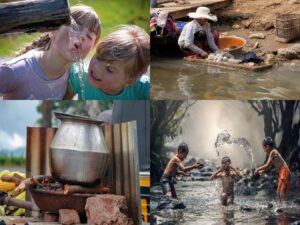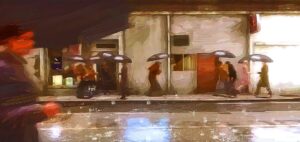Water

Summary
Water a substance composed of the chemical elements hydrogen and oxygen and existing in gaseous liquid and solid states.
How much water do we use?

Throughout the day, measure the amount of water used for each activity by you and other family members. Use a mug, a glass, a bucket or any other container to measure the amount of water used amount of water used by you for personal cleanliness in a day. Each person uses about 80-100 gallon of water per day for indoor home uses. The largest of household water is to flush the toilet and after that to take shower and bath. Our planet is 75% of that water is salt water. We have 2.5% of fresh water the drink.
WHERE DO WE GET WATER FROM?

We get water from River, spring , pond well or hand pump”. It is then supplied through a network of pipes. We get water into our homes in different ways. The water in the oceans and seas has many salts dissolved in it — the water is saline. So, it is not fit for drinking and other domestic, agricultural and industrial needs oceans play an important role in supplying the water that we use.
WATER CYCLE

It is also known as the hydrologic cycle it is continuous movement of water above and below the surface of the earth. The mass of eater on earth remains fairly constant over time but the partitioning of water into the major reservoirs of ice, fresh water, saline water and atmosphere water is variable depending on wide range of climatic variables. The water removes from one reservoir to another, such as from river to oceans or from the ocean to the atmosphere by the physical processes of evaporation, condensation, precipitation, infiltration, surface runoff, and subsurface flow. In doing so the water goes through different forms liquid solid and vapor.
Disappearing trick of Water

Water vapours so formed become a part of the air and cannot usually be seen. We also found that heating is essential to convert water into its vapour.
Water spilled on a floor dries up after, the water seems to disappear. Similarly, water disappears from wet clothes as they dry up Water from wet roads, rooftops and a few other places also disappears after the rains and its goes. During the daytime all the air surrounding us gets heated. This warm air provides heat for evaporation of water in the shade. Thus, evaporation takes place from all open surfaces of water. As a result, water vapor gets continuously this warm air provides heat for evaporation of water in the shade. Thus, evaporation takes place from all open surfaces of water. That is why we rarely notice its loss from a bucket full of water. In sunlight, evaporation takes place faster. On heating water on a burner, its evaporation takes place even faster.
Loss of Water by Plants
Plants use a part of this water to prepare their food and retain some of it in their different parts. Remaining part of this water is released by the plants into air, as water vapor through the process of transpiration. Water vapour enters the air through the processes of evaporation and transpiration.
How are Clouds formed?

Water in the form of vapour goes into air by evaporation and transpiration, forms clouds, and then comes back to the ground as rain, hail or snow.
BACK TO THE OCEANS
Most of the water that falls on the land as rain and snow sooner or later goes back to the oceans, Snow in the mountains melts into water. This water flows down the mountains in the form of streams and rivers . Some of the water that falls on land as rain, also flows in the form of rivers and streams. Most of the rivers cover long distances on land and ultimately fall into a sea or an ocean The rainwater also fills up the lakes and ponds. A part of the rainwater gets absorbed by the ground and seems to disappear in the soil. water is brought back to the air by the process of evaporation and transpiration. The rest seeps into the ground. Most of this water becomes available to us as ground water Ground water is the source for many lakes as well. It is also this ground water which is drawn by a hand pump or a tube well.
WHAT IF IT RAINS HEAVILY

Rains bring relief especially after hot summer days. The sowing of many crops depends on the arrival of monsoon. excess of rainfall may lead to many problems. rains may lead to rise in the level of water in rivers, lakes and ponds. The water may then spread over large areas causing floods. The crop fields, forests, villages, and cities may get submerged by water, floods cause extensive damage to crops, domestic animals, property and human life. The animals living in water also get carried away with the water. They often get trapped on land areas and die when floodwater recedes .It also affect the animals living in the soil.
WHAT HAPPENS IF IT DOES NOT RAIN FOR A LONG PERIOD?
The soil continues to lose water by evaporation and transpiration. Since it is not being brought back by rain, the soil becomes dry. The level of water in ponds and wells of the region goes down and some of them may even dry up. The ground water may also become scarce. This may lead to drought it is difficult to get food and fodder.
HOW CAN WE CONSERVE WATER?
Earth is fit for use of plants, animals and humans Most of the water is in the oceans and it cannot be used directly. When the level of the ground water decreases drastically, this can not be used any more. The total amount of water on Earth remains the same, but, the water available for use is very limited and is decreasing with over usage. The demand for water is increasing day-by-day. The number of people using water is increasing with rising population. In many cities, long queues for collection of water are a common site more and more water is being used for producing food and by the industries. These factors are leading, to shortage of water in many parts of the world. Hence, it is very important that water is used carefully take care not to waste water.
RAINWATER HARVESTING
Collect rain water and store it for later use. Collecting rainwater in this way is called rainwater harvesting.
Two techniques of rainwater harvesting are
Rooftop rainwater harvesting: the rainwater is collected from the rooftop to a storage tank, through pipes. This water may contain soil from the roof and need filtering before it is used. the pipes can go directly into a pit in the ground. This then seeps into the soil to recharge or refill the ground water.
Another option is to allow water to go into the ground directly from the roadside drains that collect rainwater.
Exercise
I.Fill up the blanks in the following
- The process of changing of water into its vapour is called Evaporation or vaporisation
- (b) The process of changing water vapour into water is called Condensation
- (c) No rainfall for a year or more may lead to Droughts in that region.
- (d) Excessive rains may cause Floods.
2. State for each of the following whether it is due to evaporation or condensation:
(a) Water drops appear on the outer surface of a glass containing cold water.
Ans:Condensation
(b) Steam rising from wet clothes while they are ironed.
Ans:Evaporation
(c) Fog appearing on a cold winter morning.
Ans:Condensation
(d) Blackboard dries up after wiping it.
Ans:Evaporation
(e) Steam rising from a hot girdle when water is sprinkled on it.
Ans:Evaporation
3. Which of the following statements are “true” ?
(a) Water vapour is present in air only during the monsoon. (False )
(b) Water evaporates into air from oceans, rivers and lakes but not from the soil.(False)
(c) The process of water changing into its vapour, is called evaporation.(False)
(d) The evaporation of water takes place only in sunlight.(False)
(e) Water vapour condenses to form tiny droplets of water in the upper layers of air where it is cooler.(True)
4.Suppose you want to dry your school uniform quickly. Would spreading it near an anghiti or heater help? If yes, how?
Ans:Yes, spreading it near heater will surely help as heater and anghiti are source of heat which vapourize the water of the wet clothes and thus help in drying
5. Take out a cooled bottle of water from refrigerator and keep it on a table. After some time you notice a droplets of water around it. Why?
Ans:The puddle of water seen around the cooled bottle of water is due to the condensation effect as the water vapour present in the air around the bottle get condensed after colliding with bottle.
6. To clean their spectacles, people often breathe out on glasses to make them wet. Explain why the glasses become wet.
Ans:Water vapour also gets released during exhalation process along with carbon dioxide The water vapour gets attached with the glasses of the spectacles and then condenses in the presence of air surrounding it and thus making it wet.
7. How are clouds formed? 8. When does a drought occur?
Ans:When the air moves up, it gets cooler and cooler and after reaching sufficient height the air becomes so cool that the water vapour present in it condenses to form tiny drops of water called droplets which remain floating in air and thus clouds are formed.
When does a drought occur?
Ans:Drought occurs when an area does not receive rainfall for a period of year or more, Also the soil continues to lose water by evaporation and transpiration and becomes dry and the ground water may also become scarce which may lead to drought.




























